#Digital Innovation Group
Text

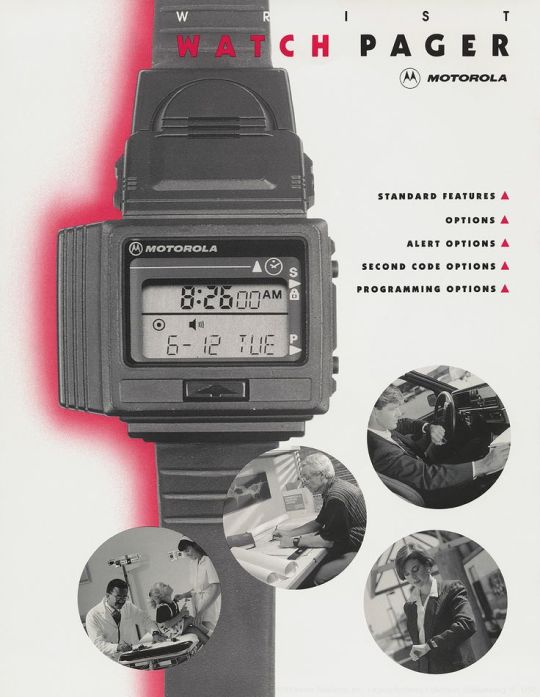


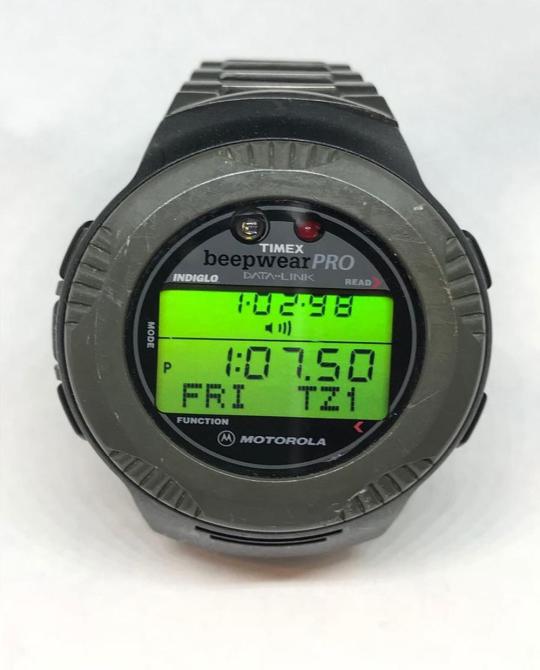
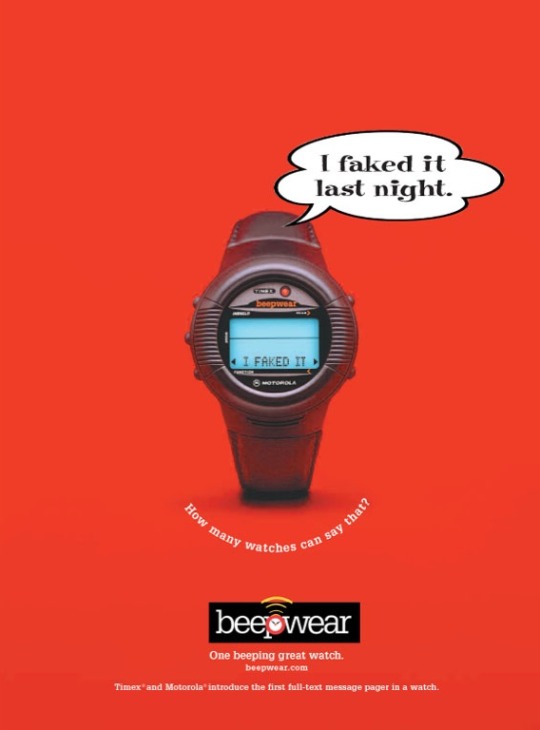
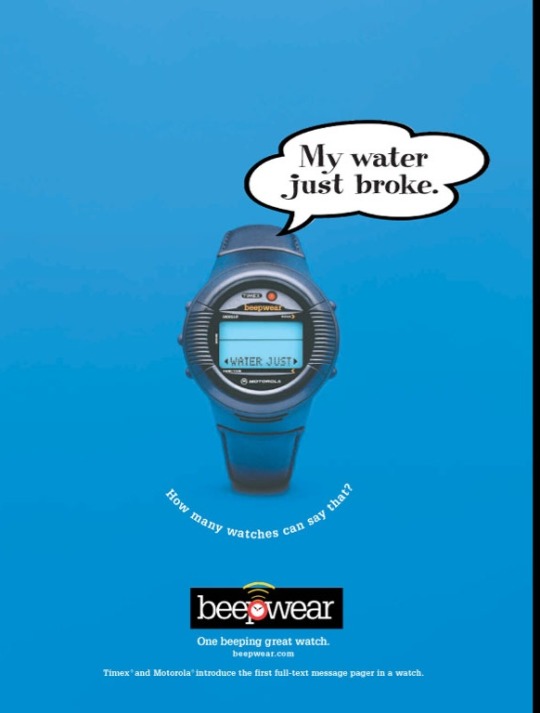
🇺🇲 Explore the Fascinating Fusion of Timekeeping and Communication: Unveiling the Pioneering Motorola and Timex Wristwatch-Pagers that Revolutionized Wearable Technology in the 1990s.
🤝 In 1990, Motorola Inc. made its first attempt to enter the market of electronic wristwatches with a built-in pager (similar devices at the same time were already produced by the Japanese companies Seiko and Casio). The device was called "Motorola Wrist Wach Pager". Since 1991, further production of the devices has been carried out jointly with the Timex Group Corporation under the name "The Timex Tracer Wrist Watch Pager".
👉 Since 1998, further development of the line of electronic watches with the participation of Motorola Inc. and Timex Group was associated with the high-tech "Timex Beepwear Datalink" series. These devices also continued the concept of wristwatch-pagers, but with the integration of the well-known Datalink data transmission platform, which integrates with desktop computer software.
➡️ The Datalink line was introduced in 1994 and was developed in conjunction with Microsoft Corporation as an alternative to conventional PDAs with added attributes such as water resistance and ease of programming. Taken together, all this made it possible to use the “Beepwear Datalink” watch as a full-fledged electronic organizer.
📟 The Beepwear Pager Watch epitomized the convergence of traditional wristwatches with cutting-edge communication capabilities. Introduced in the late 1990s, this innovative device redefined the concept of wearable tech, offering users unparalleled convenience and connectivity on the go.
📞 Equipped with pager functionality, the Beepwear Pager Watch allowed users to receive important notifications and messages directly on their wrist, eliminating the need for separate communication devices. With its sleek and compact design, it seamlessly integrated into everyday life, providing instant access to critical information wherever you went.
⌚️ Beyond its communication features, the Beepwear Pager Watch retained the timeless appeal of a classic timepiece, boasting a stylish and durable design that stood the test of time. With its reliable quartz movement and rugged construction, it was built to withstand the rigors of daily wear, ensuring longevity and reliability for its users.
⚙️ The "Beepware" series, as a joint product of the efforts of Timex Group and Motorola Inc. was patented, and the production of the devices was carried out by the newly created joint company "Beepwear Paging Products". The clock operated in the 900 MHz band. FLEX time was also used, which, if supported by the operator, could synchronize the clock time with the network time, and also automatically adjust to the owner's time zone.
🚀 The launch of the Timex Motorola Beepwear Pager Watch marked a significant milestone in the evolution of wearable technology, showcasing the potential for seamless integration of communication and timekeeping functions in a single device. As one of the pioneering products in this category, it paved the way for future innovations in the wearable tech industry, inspiring a new generation of smartwatches and wearable devices.
💔 However, already in 2002, Motorola Inc. was forced to carry out internal restructuring, including ceasing production and support of its own pagers.
💫 Today, the legacy of the Timex Motorola Beepwear Pager Watch lives on, remembered as a trailblazer in the realm of wearable technology. While newer devices may offer more advanced features, the Beepwear Pager Watch remains a symbol of innovation and ingenuity, reminding us of the transformative power of technology in shaping our lives.
#timetrek#brands#clock#watch#watches#time#companies#company#history#luxury watches#motorola#timex group#timex watches for men#timex#beepwear#pager#wristwatch#wrist watch#wristwatch pda#wristwatch pager#datalink#microsoft#smartwatch#digital watch#casio#seiko#made in usa#telecommunications#innovation#old gadgets
20 notes
·
View notes
Text
youtube
#youtube#militarytraining#Cyber Security#Cyber Resilience#Information Security#Cyber Attacks#Government Cybersecurity#Cyber Threats#National Security#Hacking Prevention#Cyber Intelligence#Cyber Warfare#Digital Warfare#Military Technology#Cyber Defense#Hackers#New Military Unit#Military Innovation#Military Operations#Cyber Strategy#National Cyber Security#Cyber Awareness#Cyber Protection#Cyber Operations#Digital Security#228th Cyberspace Operations Group#Cyber Technology
0 notes
Text
Om Digi Group's Website Developers: Masters of Digital Craftsmanship
Crafting Digital Excellence
Om Digi Group's website developers are renowned for their mastery in crafting digital excellence. With expertise in a wide array of programming languages and development frameworks, they bring creativity and precision to every project they undertake. From conceptualization to execution, their attention to detail ensures that each website they develop is not just functional but also visually stunning.
Tailored Solutions for Unique Needs
Understanding that every client has unique goals and requirements, Om Digi Group's website developers offer tailored solutions to meet specific needs. They collaborate closely with clients, delving into their objectives, target audience, and brand identity. This collaborative approach ensures that each website is custom-built to resonate with the client's vision and objectives.
Innovation Driven Development
Innovation is ingrained in Om Digi Group's ethos, and its website developers are at the forefront of driving digital innovation. They stay updated on the latest technologies and trends, constantly exploring new tools and techniques to enhance their craft. By embracing innovation, they create websites that not only meet but exceed expectations, setting new standards in the industry.
User-Centric Design Philosophy
Om Digi Group's website developers prioritize user experience above all else. They understand that a website's success hinges on its ability to engage and delight users. Therefore, they adopt a user-centric design philosophy, focusing on intuitive navigation, clear calls-to-action, and seamless interactions. By putting the user first, they ensure that each website delivers a memorable and engaging experience for visitors.
#Crafting Digital Excellence#Om Digi Group's website developers are renowned for their mastery in crafting digital excellence. With expertise in a wide array of program#they bring creativity and precision to every project they undertake. From conceptualization to execution#their attention to detail ensures that each website they develop is not just functional but also visually stunning.#Tailored Solutions for Unique Needs#Understanding that every client has unique goals and requirements#Om Digi Group's website developers offer tailored solutions to meet specific needs. They collaborate closely with clients#delving into their objectives#target audience#and brand identity. This collaborative approach ensures that each website is custom-built to resonate with the client's vision and objectiv#Innovation Driven Development#Innovation is ingrained in Om Digi Group's ethos#and its website developers are at the forefront of driving digital innovation. They stay updated on the latest technologies and trends#constantly exploring new tools and techniques to enhance their craft. By embracing innovation#they create websites that not only meet but exceed expectations#setting new standards in the industry.#User-Centric Design Philosophy#Om Digi Group's website developers prioritize user experience above all else. They understand that a website's success hinges on its abilit#they adopt a user-centric design philosophy#focusing on intuitive navigation#clear calls-to-action#and seamless interactions. By putting the user first#they ensure that each website delivers a memorable and engaging experience for visitors.#website developers
1 note
·
View note
Text
Alibaba Group: Revolutionizing Global Trade and Commerce"
Alibaba Group Holding Limited, founded in 1999 by Jack Ma, is a multinational conglomerate based in China that specializes in e-commerce, retail, internet, and technology. With a mission to make it easy to do business anywhere, Alibaba has transformed the landscape of global trade and commerce. Here’s an overview of Alibaba’s key businesses and its impact on various sectors
1. E-Commerce…

View On WordPress
#Alibaba Group#Cloud Computing#Digital Entertainment#E-commerce#Financial Services#Global Expansion#Innovation#Logistics#Supply Chain#Technology
0 notes
Text
also in regards to that last article about varied ways of thinking about psychosis/altered states that don't just align with medical model or carceral psychiatry---I always love sharing about Bethel House and their practices of peer support for schizophrenia that are founded on something called tojisha kenkyu, but I don't see it mentioned as often as things like HVN and Soteria House.

ID: [A colorful digital drawing of a group of people having a meeting inside a house while it snows outside.]
"What really set the stage for tōjisha-kenkyū were two social movements started by those with disabilities. In the 1950s, a new disability movement was burgeoning in Japan, but it wasn’t until the 1970s that those with physical disabilities, such as cerebral palsy, began to advocate for themselves more actively as tōjisha. For those in this movement, their disability is visible. They know where their discomfort comes from, why they are discriminated against, and in what ways they need society to change. Their movement had a clear sense of purpose: make society accommodate the needs of people with disabilities. Around the same time, during the 1970s, a second movement was started by those with mental health issues, such as addiction (particularly alcohol misuse) and schizophrenia. Their disabilities are not always visible. People in this second movement may not have always known they had a disability and, even after they identify their problems, they may remain uncertain about the nature of their disability. Unlike those with physical and visible disabilities, this second group of tōjisha were not always sure how to advocate for themselves as members of society. They didn’t know what they wanted and needed from society. This knowing required new kinds of self-knowledge.
As the story goes, tōjisha-kenkyū emerged in the Japanese fishing town of Urakawa in southern Hokkaido in the early 2000s. It began in the 1980s when locals who had been diagnosed with psychiatric disorders created a peer-support group in a run-down church, which was renamed ‘Bethel House’. The establishment of Bethel House (or just Bethel) was also aided by the maverick psychiatrist Toshiaki Kawamura and an innovative social worker named Ikuyoshi Mukaiyachi. From the start, Bethel embodied the experimental spirit that followed the ‘antipsychiatry’ movement in Japan, which proposed ideas for how psychiatry might be done differently, without relying only on diagnostic manuals and experts. But finding new methods was incredibly difficult and, in the early days of Bethel, both staff and members often struggled with a recurring problem: how is it possible to get beyond traditional psychiatric treatments when someone is still being tormented by their disabling symptoms? Tōjisha-kenkyū was born directly out of a desperate search for answers.
In the early 2000s, one of Bethel’s members with schizophrenia was struggling to understand who he was and why he acted the way he did. This struggle had become urgent after he had set his own home on fire in a fit of anger. In the aftermath, he was overwhelmed and desperate. At his wits’ end about how to help, Mukaiyachi asked him if perhaps he wanted to kenkyū (to ‘study’ or ‘research’) himself so he could understand his problems and find a better way to cope with his illness. Apparently, the term ‘kenkyū’ had an immediate appeal, and others at Bethel began to adopt it, too – especially those with serious mental health problems who were constantly urged to think about (and apologise) for who they were and how they behaved. Instead of being passive ‘patients’ who felt they needed to keep their heads down and be ashamed for acting differently, they could now become active ‘researchers’ of their own ailments. Tōjisha-kenkyū allowed these people to deny labels such as ‘victim’, ‘patient’ or ‘minority’, and to reclaim their agency.
Tōjisha-kenkyū is based on a simple idea. Humans have long shared their troubles so that others can empathise and offer wisdom about how to solve problems. Yet the experience of mental illness is often accompanied by an absence of collective sharing and problem-solving. Mental health issues are treated like shameful secrets that must be hidden, remain unspoken, and dealt with in private. This creates confused and lonely people, who can only be ‘saved’ by the top-down knowledge of expert psychiatrists. Tōjisha-kenkyū simply encourages people to ‘study’ their own problems, and to investigate patterns and solutions in the writing and testimonies of fellow tōjisha.
Self-reflection is at the heart of this practice. Tōjisha-kenkyū incorporates various forms of reflection developed in clinical methods, such as social skills training and cognitive behavioural therapy, but the reflections of a tōjisha don’t begin and end at the individual. Instead, self-reflection is always shared, becoming a form of knowledge that can be communally reflected upon and improved. At Bethel House, members found it liberating that they could define themselves as ‘producers’ of a new form of knowledge, just like the doctors and scientists who diagnosed and studied them in hospital wards. The experiential knowledge of Bethel members now forms the basis of an open and shared public domain of collective knowledge about mental health, one distributed through books, newspaper articles, documentaries and social media.
Tōjisha-kenkyū quickly caught on, making Bethel House a site of pilgrimage for those seeking alternatives to traditional psychiatry. Eventually, a café was opened, public lectures and events were held, and even merchandise (including T-shirts depicting members’ hallucinations) was sold to help support the project. Bethel won further fame when their ‘Hallucination and Delusion Grand Prix’ was aired on national television in Japan. At these events, people in Urakawa are invited to listen and laugh alongside Bethel members who share stories of their hallucinations and delusions. Afterwards, the audience votes to decide who should win first prize for the most hilarious or moving account. One previous winner told a story about a failed journey into the mountains to ride a UFO and ‘save the world’ (it failed because other Bethel members convinced him he needed a licence to ride a UFO, which he didn’t have). Another winner told a story about living in a public restroom at a train station for four days to respect the orders of an auditory hallucination. Tōjisha-kenkyū received further interest, in and outside Japan, when the American anthropologist Karen Nakamura wrote A Disability of the Soul: An Ethnography of Schizophrenia and Mental Illness in Contemporary Japan (2013), a detailed and moving account of life at Bethel House. "
-Japan's Radical Alternative to Psychiatric Diagnosis by Satsuki Ayaya and Junko Kitanaka
#personal#psych abolition#mad liberation#psychosis#altered states#antipsych#antipsychiatry#mad pride#peer support#schizophrenia#i have a pdf of the book somewhere if anyone wants#the book and the documentary also discuss some of the pratical struggles in creating a community like this which i also found helpful as#someone who is very interested in helping open a peer respite.
2K notes
·
View notes
Text
How lock-in hurts design

Berliners: Otherland has added a second date (Jan 28) for my book-talk after the first one sold out - book now!

If you've ever read about design, you've probably encountered the idea of "paving the desire path." A "desire path" is an erosion path created by people departing from the official walkway and taking their own route. The story goes that smart campus planners don't fight the desire paths laid down by students; they pave them, formalizing the route that their constituents have voted for with their feet.
Desire paths aren't always great (Wikipedia notes that "desire paths sometimes cut through sensitive habitats and exclusion zones, threatening wildlife and park security"), but in the context of design, a desire path is a way that users communicate with designers, creating a feedback loop between those two groups. The designers make a product, the users use it in ways that surprise the designer, and the designer integrates all that into a new revision of the product.
This method is widely heralded as a means of "co-innovating" between users and companies. Designers who practice the method are lauded for their humility, their willingness to learn from their users. Tech history is strewn with examples of successful paved desire-paths.
Take John Deere. While today the company is notorious for its war on its customers (via its opposition to right to repair), Deere was once a leader in co-innovation, dispatching roving field engineers to visit farms and learn how farmers had modified their tractors. The best of these modifications would then be worked into the next round of tractor designs, in a virtuous cycle:
https://securityledger.com/2019/03/opinion-my-grandfathers-john-deere-would-support-our-right-to-repair/
But this pattern is even more pronounced in the digital world, because it's much easier to update a digital service than it is to update all the tractors in the field, especially if that service is cloud-based, meaning you can modify the back-end everyone is instantly updated. The most celebrated example of this co-creation is Twitter, whose users created a host of its core features.
Retweets, for example, were a user creation. Users who saw something they liked on the service would type "RT" and paste the text and the link into a new tweet composition window. Same for quote-tweets: users copied the URL for a tweet and pasted it in below their own commentary. Twitter designers observed this user innovation and formalized it, turning it into part of Twitter's core feature-set.
Companies are obsessed with discovering digital desire paths. They pay fortunes for analytics software to produce maps of how their users interact with their services, run focus groups, even embed sneaky screen-recording software into their web-pages:
https://www.wired.com/story/the-dark-side-of-replay-sessions-that-record-your-every-move-online/
This relentless surveillance of users is pursued in the name of making things better for them: let us spy on you and we'll figure out where your pain-points and friction are coming from, and remove those. We all win!
But this impulse is a world apart from the humility and respect implied by co-innovation. The constant, nonconsensual observation of users has more to do with controlling users than learning from them.
That is, after all, the ethos of modern technology: the more control a company can exert over its users ,the more value it can transfer from those users to its shareholders. That's the key to enshittification, the ubiquitous platform decay that has degraded virtually all the technology we use, making it worse every day:
https://pluralistic.net/2023/02/19/twiddler/
When you are seeking to control users, the desire paths they create are all too frequently a means to wrestling control back from you. Take advertising: every time a service makes its ads more obnoxious and invasive, it creates an incentive for its users to search for "how do I install an ad-blocker":
https://www.eff.org/deeplinks/2019/07/adblocking-how-about-nah
More than half of all web-users have installed ad-blockers. It's the largest consumer boycott in human history:
https://doc.searls.com/2023/11/11/how-is-the-worlds-biggest-boycott-doing/
But zero app users have installed ad-blockers, because reverse-engineering an app requires that you bypass its encryption, triggering liability under Section 1201 of the Digital Millennium Copyright Act. This law provides for a $500,000 fine and a 5-year prison sentence for "circumvention" of access controls:
https://pluralistic.net/2024/01/12/youre-holding-it-wrong/#if-dishwashers-were-iphones
Beyond that, modifying an app creates liability under copyright, trademark, patent, trade secrets, noncompete, nondisclosure and so on. It's what Jay Freeman calls "felony contempt of business model":
https://locusmag.com/2020/09/cory-doctorow-ip/
This is why services are so horny to drive you to install their app rather using their websites: they are trying to get you to do something that, given your druthers, you would prefer not to do. They want to force you to exit through the gift shop, you want to carve a desire path straight to the parking lot. Apps let them mobilize the law to literally criminalize those desire paths.
An app is just a web-page wrapped in enough IP to make it a felony to block ads in it (or do anything else that wrestles value back from a company). Apps are web-pages where everything not forbidden is mandatory.
Seen in this light, an app is a way to wage war on desire paths, to abandon the cooperative model for co-innovation in favor of the adversarial model of user control and extraction.
Corporate apologists like to claim that the proliferation of apps proves that users like them. Neoliberal economists love the idea that business as usual represents a "revealed preference." This is an intellectually unserious tautology: "you do this, so you must like it":
https://boingboing.net/2024/01/22/hp-ceo-says-customers-are-a-bad-investment-unless-they-can-be-made-to-buy-companys-drm-ink-cartridges.html
Calling an action where no alternatives are permissible a "preference" or a "choice" is a cheap trick – especially when considered against the "preferences" that reveal themselves when a real choice is possible. Take commercial surveillance: when Apple gave Ios users a choice about being spied on – a one-click opt of of app-based surveillance – 96% of users choice no spying:
https://arstechnica.com/gadgets/2021/05/96-of-us-users-opt-out-of-app-tracking-in-ios-14-5-analytics-find/
But then Apple started spying on those very same users that had opted out of spying by Facebook and other Apple competitors:
https://pluralistic.net/2022/11/14/luxury-surveillance/#liar-liar
Neoclassical economists aren't just obsessed with revealed preferences – they also love to bandy about the idea of "moral hazard": economic arrangements that tempt people to be dishonest. This is typically applied to the public ("consumers" in the contemptuous parlance of econospeak). But apps are pure moral hazard – for corporations. The ability to prohibit desire paths – and literally imprison rivals who help your users thwart those prohibitions – is too tempting for companies to resist.
The fact that the majority of web users block ads reveals a strong preference for not being spied on ("users just want relevant ads" is such an obvious lie that doesn't merit any serious discussion):
https://www.iccl.ie/news/82-of-the-irish-public-wants-big-techs-toxic-algorithms-switched-off/
Giant companies attained their scale by learning from their users, not by thwarting them. The person using technology always knows something about what they need to do and how they want to do it that the designers can never anticipate. This is especially true of people who are unlike those designers – people who live on the other side of the world, or the other side of the economic divide, or whose bodies don't work the way that the designers' bodies do:
https://pluralistic.net/2022/10/20/benevolent-dictators/#felony-contempt-of-business-model
Apps – and other technologies that are locked down so their users can be locked in – are the height of technological arrogance. They embody a belief that users are to be told, not heard. If a user wants to do something that the designer didn't anticipate, that's the user's fault:
https://www.wired.com/2010/06/iphone-4-holding-it-wrong/
Corporate enthusiasm for prohibiting you from reconfiguring the tools you use to suit your needs is a declaration of the end of history. "Sure," John Deere execs say, "we once learned from farmers by observing how they modified their tractors. But today's farmers are so much stupider and we are so much smarter that we have nothing to learn from them anymore."
Spying on your users to control them is a poor substitute asking your users their permission to learn from them. Without technological self-determination, preferences can't be revealed. Without the right to seize the means of computation, the desire paths never emerge, leaving designers in the dark about what users really want.
Our policymakers swear loyalty to "innovation" but when corporations ask for the right to decide who can innovate and how, they fall all over themselves to create laws that let companies punish users for the crime of contempt of business-model.
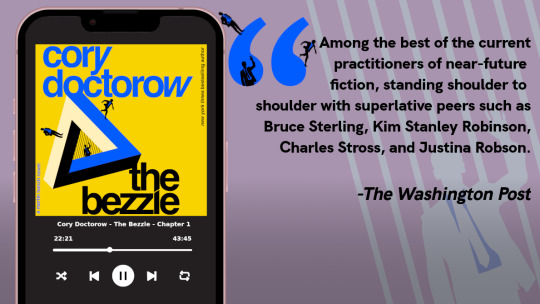
I'm Kickstarting the audiobook for The Bezzle, the sequel to Red Team Blues, narrated by @wilwheaton! You can pre-order the audiobook and ebook, DRM free, as well as the hardcover, signed or unsigned. There's also bundles with Red Team Blues in ebook, audio or paperback.

If you'd like an essay-formatted version of this post to read or share, here's a link to it on pluralistic.net, my surveillance-free, ad-free, tracker-free blog:
https://pluralistic.net/2024/01/24/everything-not-mandatory/#is-prohibited

Image:
Belem (modified)
https://commons.wikimedia.org/wiki/File:Desire_path_%2819811581366%29.jpg
CC BY 2.0
https://creativecommons.org/licenses/by/2.0/deed.en
#pluralistic#desire paths#design#drm#everything not mandatory is prohibited#apps#ip#innovation#user innovation#technological self-determination#john deere#twitter#felony contempt of business model
3K notes
·
View notes
Text
BMW i Vision Dee: Almost Human
BMW i Vision Dee: Almost Human
Imagine a world where your automobile recognizes who you are when you approach, and greets you by name.
A world where the iconic BMW “Kidney” grille can produce different facial expressions, like a smile.
A world where you can choose from 32 different colors for your car, and change them from one to another color at will.
A world where the high-tech in your car…

View On WordPress
#Bavarian Motor Works#BMW#BMW Automotive#BMW Digitalization#BMW e Ink#BMW electric cars#BMW electric vehicles#BMW Electrification#BMW Group#BMW History#BMW I Vision#BMW i Vision Dee#BMW I Vision Vehicle#BMW Innovation#BMW Motorrad#BMW Museum#BMW Museum Munich#BMW Pioneering#BMW Technology#BMW USA#BMW Welt#BMW Welt Munich#Cars of the future#CES 2023#Digital Emotional Experience#Future#future cars#Future Vehicles#Hydrogen Fuel Cell Cars#Las Vegas conferences
1 note
·
View note
Text
"The alliterate one was yelling at a producer after the interview." 🤔
Well of course she did 🤪



By the way, it is past time for Jane Pauley to retire. Jane couldn't see the difference between Sparry's hand & his thigh : "...and I see you touch your HUSBAND'S HAND in just the way I knew you would be looking after one another."



Someone is Off Script 🤪😂





HAPPY Meg: to speak about her fake unaliving & the tell tell: "I wasn't expecting that..." She had a SCRIPT on the ready, along w/yet another veiled threat to the BRF
ANGRY Meg: Pauley said, "the 2 of you, a modest beginning it's NOT an army (yet). What are your ambitions?" This was the 1 time Pauley went off script.

Like vinegar in Meg's mouth: "you have to start somewhere..." BUSTED!
This "network" is a smokescreen, an illusion. The Meghans are tragedy vultures who grift off the pain of parents whose children are deceased. They intend to exploit these parents to pass legislation like KOSA, to criminalize online criticism and monitor social credit scores
Tragedy Vultures
Oh look, she's latched onto another mother of a deceased child. 🤔 ⚰


Q-Where did these TRAGEDY VULTURES meet the bereaved parents?⚰

A-They met these bereaved parents in October 2023 in NYC for the 2nd annual World Mental Health Day. archeFRAUD Partnered with Project Healthy Minds (Carson Daily) to target the potential activism of this niche group of bereaved parents who experienced the unthinkable----a child gone too soon.

archeFRAUD plans to use their website and resources as an online hub of "connection" for the parent bereavement stories. The financial backers are: the radical left NAACP, Boston's radical left Fairplay, ParentsSOS, Center for Humane Technology, George Soros Open Societies Foundations, Omisyar Network, Craig Newmark Foundation, Robert Wood Johnson Foundation, Silicon Valley Community Foundation, Ford Foundation, Pritzker Family Foundation, Pritzker Innovation Fund, Parent's For Safe Online Spaces, David's Legacy Foundation, etc.
They intend to use untouchable stories of sorrow & death to bully Congress into criminalizing online criticism. This has been a longtime mission for elites like noprah, tyler perry, hollyweird stars, celebrity & political island visitors made up of wealthy elites who do illegal deeds in the shadows. These groups have been on a 20 year mission to go back to the comfort & secrecy of the pre-internet era. They are desperate for their wicked deeds to remain in the dark, but they need forward facing idiots like Meghan & Sparry to serve as their mouthpieces.
ME-gain & Sparry are tragedy vultures, grifting off the grief of bereaved families. Their mission to "raise awareness by sharing these parent stories" is to criminalize online online users for "hate speech" aka any criticism of ME-gain via the digital online town square. The NAACP is money laundering to meet the elites digital justice goals. Please contact Congress to Stop KOSA.
The October 2023 Comments under this Access Hollyweird video are GOLD!!

#tragedy vultures#george soros#spare us#worldwide privacy tour#megxit#blind items#archeFRAUD#cBS#oprah winfrey#jane pauley#project healthy minds#meghan markle is a bully#meghan markle is a liar#43% nigerian scam#bereaved parents pilot/retreat#gayle king#meghan markle is mentally ill#grifters gonna grift#james holt#parrent connection#stage & scripted#train wreck#NAACP#stop kosa#digital justice#criminalizing online criticism#parent connect#naacp#grief#recollections may vary
97 notes
·
View notes
Text

1969 Holden Hurricane Concept

1969 Holden Hurricane Concept

1969 Holden Hurricane Concept

1969 Holden Hurricane Concept

1969 Holden Hurricane Concept
Holden has gone back to the future, restoring its very first concept car - the 1969 Holden Hurricane Concept.
The futuristic research vehicle described as an experiment "to study design trend, propulsion systems and other long range developments" has been restored to its former glory as a labour of love by a dedicated group of Holden designers and engineers.
Code named RD 001; the Holden Hurricane is a mid-engined, rear-wheel drive, two-seater sports car which incorporates a remarkable array of innovative features and technology, much of it way ahead of its time.
Features such as electronic digital instrument displays, station-seeking radio, automatic temperature control air conditioning, rear vision camera and an automated route finder were all showcased in this ground-breaking vehicle 42 years ago. Many of these technologies have only recently made their way into mass production, demonstrating Holden's remarkable foresight into both design and engineering technology.
The Holden Hurricane stole headlines and dropped jaws nationwide when it debuted at the 1969 Melbourne Motor Show.
Michael Simcoe, Executive Director GMIO Design, said it was fantastic to see such a significant vehicle restored.
"At Holden we have always prided ourselves on our ability to look into the future through our concept cars," Mr Simcoe said.
"It's amazing to think that the features we take for granted today were born out of creative minds over 40 years ago."
As its code name suggests, the RD 001 was the first product of the GMH Research and Development organisation, staffed by a small squad of engineers working in conjunction with the Advance Styling Group at the Fishermans Bend Technical Centre in the 1960s.
The team that designed and built the original Holden Hurricane employed some advanced technologies and techniques when it came to the powertrain. Powered by an experimental 4.2-litre (253 cubic inch) V8, this engine was a precursor to the Holden V8 engine program which entered production in late 1969.
The Holden Hurricane's V8 engine featured many advanced design components such as the four-barrel carburettor - a feature which wouldn't be seen on a production 253ci Holden V8 until the late 1970s. The end result was approximately 262hp (193kW), a towering power output in 1969 and one that ensured the Holden Hurricane had the go to match its show.
But perhaps the two most innovative features were the "Pathfinder" route guidance system and the rear-view camera.
The "Pathfinder", essentially a pre-GPS navigation system, relied on a system of magnets embedded at intersections along the road network to guide the driver along the desired route. A dash-mounted panel informed the driver of which turn to take by illuminating different arrows, as well as sounding a warning buzzer.
The rear-view camera was also a ground-breaking innovation.
Engineers using a Closed Circuit Television (CCTV) system with a camera mounted in the rear bumper feeding vision to a small black-and-white TV mounted in the centre console.
Former Holden Chief Studio Engineer Rick Martin led the modern-day Hurricane team in researching the vehicle's components, systems and history in order to restore it.
"There are some genuinely remarkable ideas and technology in the Hurricane," said Mr Martin.
"From the automatic air-conditioning and magnet-based guidance system, to the inertia-reel seat belts and metallic paint, this was a car that was genuinely ahead of its time.
"The hand-picked team of engineers and designers who built the original Holden Hurricane worked in strict secrecy and began Holden's now proud tradition of ground-breaking concept cars."
RD 001 stands just 990mm high and has no doors in the conventional sense. A hydraulically-powered canopy opens upwards and forward over the front wheels, combined with twin "astronaut type" power-elevating seats which rise up and pivot forward, along with the steering column for ease of access. Occupants are then lowered to a semi-reclining position before the roof closes over them.
The wind tunnel-tested fibreglass body consists of three segments; the canopy, the engine hood and body shell and was finished in an experimental aluminium flake-based metallic orange paint.
Safety innovations included a foam-lined fuel tank, integrated roll-over bar, digital instrument readouts, ignition safety locks, interior padding and a fire warning system.
The project to restore RD 001 began in 2006 and has been a genuine labour of love for some very dedicated Holden employees. The entire restoration process has been driven primarily by volunteer labour from Holden designers and engineers in their spare time.
But the Hurricane first entered Holden Design in less than immaculate condition. RD 001 had a residency in a trade school where apprentices practised their welding on the priceless concept.
After being returned to Holden in 2006, the Hurricane restoration project has taken many thousands of painstaking man hours to lovingly restore RD 001 to concourse condition.
Holden's Manager for Creative Hard Modelling, Paul Clarke, has been largely responsible for managing the restoration of RD 001. He ensured as many of the original parts as possible have been used or remade using modern techniques to 1969 specification, in order to preserve the authenticity of this hugely important Holden.
"The entire team has done a fantastic job in bringing this beautiful concept back to life," Mr Clarke said.
"The talent we have within the Holden organisation is simply outstanding. Every time we take on a project I'm constantly amazed by the passion and talent in this company, making it a genuine pleasure to work on these projects.
"The Hurricane plays a crucial role in Holden's story and the company has such a great sense of history and heritage that it was very important to bring RD 001 back to life. It's been a challenging but incredibly rewarding process."
Since the debut of the Holden Hurricane Concept in 1969, Holden has continued to build a global reputation for envisioning and executing world-class concept vehicles. Holden is recognised globally within General Motors as a centre of excellence for concept vehicle and show car development and is one of only three GM design studios that is capable to design and build concept cars.
Michael Simcoe added that the Hurricane holds a particularly special place in Holden's history as it kick-started Holden's long love affair with concepts that has since seen the likes of the iconic GTR-X, Torana TT36, Coupe 60, the GMC Denali XT (which was requested specifically by GM for the North American market) and the award-winning Efijy.
Holden Hurricane Concept (1969)
55 notes
·
View notes
Text
✜ Articon #10 ✜ UX측면에서 본 Facebook Home의 실패 이유와 개선되어야 할 부분들 그리고 브랜드 런쳐의 방향성
이번부터 모바일 관련된 컨텐츠로 진행하려 했으나 디지털 업계에 대한 부분도 그냥 지나칠 수 없기에 전전 컨텐츠에 이어 페이스북 홈에 관련된 내용 한번 짚고 넘어가려고 합니다. 지난번 페이스북 홈에 대해 언급한 글을 참조 하시려면 여기를 클릭하십시요. “Facebook Launcher 개발이 각 기업과 우리(마케터, UX디자이너, 개발자)에게 주는 중요한 의미”
4월 21일 기준 Google Play에서 Facebook Home에 대한 평가를 보면 별5개가 1,743명, 별1개가 5,439명입니다. 이정도면 실패라고 봐야 할 점수인데요. 왜 이런 반응이 나왔을까요? 개인적으로 처음 스크린샷이 나왔을때부터 테스트해보고 싶은 맘이 안들어 관심을 놓고 있었는데, 아무래도 UX에 대한 평가를 해야겠다는 생각이 들어…

View On WordPress
#Android#application#Apps#artcoon#articon#Atom Launcher#Back(Launcher)#Cover Feed#Digital Innovation#Digital Innovation Group#디지털 마케팅#디지털 이노베이션#런처#마케터#모바일#모바일 마케팅#모바일 앱#모바일 전략#미래전략#개발자#브랜드 런쳐#브랜드 가치#기업의 미래#facebook#Facebook Home#Go Launcher EX#Innovation#페이스북#페이스북 런처#페이스북 홈
0 notes
Text
✨PART OF FORTUNE IN SIGNS AND HOUSES SERIES: 11TH HOUSE✨
Credit: Tumblr blog @astroismypassion
ARIES PART OF FORTUNE IN THE 11TH HOUSE
You feel the most abundant when you have Aries and Aquarius Sun people in your life. You can earn money via launching or joining a tech startup, focused on innovative technologies or disruptive business model, via work in community organization or activism, via work in digital marketing or social media management, via providing consulting services to businesses or organizations, advising them on innovation strategies, product development or new market exploration, via work in crowdfunding or fundraising. You feel abundant when you align with social causes, focus on group dynamics and embrace innovation.
TAURUS PART OF FORTUNE IN THE 11TH HOUSE
You feel the most abundant when you have Taurus and Aquarius Sun people in your life. You can earn money via work in investment management, focusing on building and managing portfolios that provide stable returns, via art colleting, dealing or curation focusing on pieces that have enduring value, via work in interior design, via work in hospitality management (in luxury hotels, resorts or event planning). You feel abundant when you embrace sustainable and ethical practices, when you practice patience and persistence.
GEMINI PART OF FORTUNE IN THE 11TH HOUSE
You feel the most abundant when you have Gemini and Aquarius Sun people in your life. You can earn money via engaging in activism, advocacy work, via work in public relations, graphic design, via creative writing, screenwriting, content creation, teaching, tutoring, joining or starting a tech company focused on innovative products or services. You feel abundant when you are focused on community, collective goals, when you stay versatile and adaptable.
CANCER PART OF FORTUNE IN THE 11TH HOUSE
You feel the most abundant when you have Cancer and Aquarius Sun people in your life. You can earn money via pursuing a career in early childhood education or childcare, nursing, caregiving, mental health services, via work in family and parent education, pursuing culinary arts or catering, engaging in art and design. You feel abundant when you focus on community, social connections, embrace technology and innovation, promote security and stability and use your intuition and emotional intelligence.
LEO PART OF FORTUNE IN THE 11TH HOUSE
You feel the most abundant when you have Leo and Aquarius Sun people in your life. You can find abundance by managing a charitable organisation. You can earn money via work as a creative director or manager, overseeing projects in fashion, advertising or design, via writing, blogging, content creation focused on inspirational and motivational themes, via work in charity or fundraising, work in teaching (drama, art, public speaking). You feel abundant when maintain confidence in your vision and abilities, when you embrace charisma, leadership and when you pursue a creative career.
VIRGO PART OF FORTUNE IN THE 11TH HOUSE
You feel the most abundant when you have Virgo and Aquarius Sun people in your life. You can earn money via work in tech support, quality assurance, systems analysis, work in non-profit management, pursuing teaching or training roles, engage in environmental research, when you organise workshops or seminars on practical skills, health and wellness. You feel abundant when you focus on health, wellness, when you network, collaborate and when you use technology.
LIBRA PART OF FORTUNE IN THE 11TH HOUSE
You feel the most abundant when you have Libra and Virgo Sun people in your life. You can create wealth by creating and selling DIY kits or tutorials. You could also learn digital or 3D art. You could sell photos on sites like Shutterstock or Adobe Stock. You earn money via event planning, specializing in weddings, social events and community events, work in legal services, such as family law, meditation or contract negotiation. You feel abundant when you embrace collaboration and partnerships, focus on aesthetics and creativity.
SCORPIO PART OF FORTUNE IN THE 11TH HOUSE
You feel the most abundant when you have Scorpio and Aquarius Sun people in your life. You can earn money via holistic healing, alternative medicine, energy work, via astrology, metaphysical studies, spiritual counselling, via biotechnology, healthcare technology, environmental technology, via work in cybersecurity, data analysis or investigative journalism. You feel abundant when embrace deep, transformative work, engage in financial and strategic roles.
SAGITTARIUS PART OF FORTUNE IN THE 11TH HOUSE
You feel the most abundant when you have Sagittarius and Aquarius Sun people in your life. You can earn money via career in diplomacy, teaching, lecturing, work in tourism industry, work in educational publishing, work in broadcasting or journalism, work in editing or translation. You feel abundant when you engage in social and humanitarian causes, focus on education and communication, when you embrace international cultural perspectives.
CAPRICORN PART OF FORTUNE IN THE 11TH HOUSE
You feel the most abundant when you have Capricorn and Aquarius Sun people in your life. You can earn money via real estate development, work in corporate training and development, taking on leadership roles in non-profit organizations that focus on social justice, community development or environmental sustainability. You feel abundant when emphasize practical, realistic approach, when you use network and social connections.
AQUARIUS PART OF FORTUNE IN THE 11TH HOUSE
You feel the most abundant when you have Aquarius Sun people in your life. You can earn money via streaming on platforms (Twitch), participating in esports or creating gaming content. You earn money via scientific research, when you create or support educational programs that focus on skills for the future (digital literacy, innovation), when you create content that explores futuristic concepts, technology trends or social change using platforms like YouTube, a blog, podcast. You feel abundant when you focus on technology and future trends and when you stay true to your unconventional nature.
PISCES PART OF FORTUNE IN THE 11TH HOUSE
You feel the most abundant when you have Pisces and Aquarius Sun people in your life. You can earn money via storytelling, work in holistic healing fields, massage therapy, via painting, writing, music or film, via offering spiritual or life coaching services. You feel abundant when stay true to your intuitive insights, embrace spiritual and healing practices and when you focus on humanitarian and compassionate work.
Credit: Tumblr blog @astroismypassion
#astrology#astroismypassion#astro notes#astroblr#astro community#astro note#astro observations#natal chart#astrology blog#chart reading#pof in the 11th house#astro observation#astrology observations#birth chart#astro#chart interpretation#scorpio#pof#aries#taurus#cancer#gemini#leo#libra#virgo#sagittarius#capricorn#aquarius#pisces#pisces pof
73 notes
·
View notes
Text
Determined to use her skills to fight inequality, South African computer scientist Raesetje Sefala set to work to build algorithms flagging poverty hotspots - developing datasets she hopes will help target aid, new housing, or clinics.
From crop analysis to medical diagnostics, artificial intelligence (AI) is already used in essential tasks worldwide, but Sefala and a growing number of fellow African developers are pioneering it to tackle their continent's particular challenges.
Local knowledge is vital for designing AI-driven solutions that work, Sefala said.
"If you don't have people with diverse experiences doing the research, it's easy to interpret the data in ways that will marginalise others," the 26-year old said from her home in Johannesburg.
Africa is the world's youngest and fastest-growing continent, and tech experts say young, home-grown AI developers have a vital role to play in designing applications to address local problems.
"For Africa to get out of poverty, it will take innovation and this can be revolutionary, because it's Africans doing things for Africa on their own," said Cina Lawson, Togo's minister of digital economy and transformation.
"We need to use cutting-edge solutions to our problems, because you don't solve problems in 2022 using methods of 20 years ago," Lawson told the Thomson Reuters Foundation in a video interview from the West African country.
Digital rights groups warn about AI's use in surveillance and the risk of discrimination, but Sefala said it can also be used to "serve the people behind the data points". ...
'Delivering Health'
As COVID-19 spread around the world in early 2020, government officials in Togo realized urgent action was needed to support informal workers who account for about 80% of the country's workforce, Lawson said.
"If you decide that everybody stays home, it means that this particular person isn't going to eat that day, it's as simple as that," she said.
In 10 days, the government built a mobile payment platform - called Novissi - to distribute cash to the vulnerable.
The government paired up with Innovations for Poverty Action (IPA) think tank and the University of California, Berkeley, to build a poverty map of Togo using satellite imagery.
Using algorithms with the support of GiveDirectly, a nonprofit that uses AI to distribute cash transfers, the recipients earning less than $1.25 per day and living in the poorest districts were identified for a direct cash transfer.
"We texted them saying if you need financial help, please register," Lawson said, adding that beneficiaries' consent and data privacy had been prioritized.
The entire program reached 920,000 beneficiaries in need.
"Machine learning has the advantage of reaching so many people in a very short time and delivering help when people need it most," said Caroline Teti, a Kenya-based GiveDirectly director.
'Zero Representation'
Aiming to boost discussion about AI in Africa, computer scientists Benjamin Rosman and Ulrich Paquet co-founded the Deep Learning Indaba - a week-long gathering that started in South Africa - together with other colleagues in 2017.
"You used to get to the top AI conferences and there was zero representation from Africa, both in terms of papers and people, so we're all about finding cost effective ways to build a community," Paquet said in a video call.
In 2019, 27 smaller Indabas - called IndabaX - were rolled out across the continent, with some events hosting as many as 300 participants.
One of these offshoots was IndabaX Uganda, where founder Bruno Ssekiwere said participants shared information on using AI for social issues such as improving agriculture and treating malaria.
Another outcome from the South African Indaba was Masakhane - an organization that uses open-source, machine learning to translate African languages not typically found in online programs such as Google Translate.
On their site, the founders speak about the South African philosophy of "Ubuntu" - a term generally meaning "humanity" - as part of their organization's values.
"This philosophy calls for collaboration and participation and community," reads their site, a philosophy that Ssekiwere, Paquet, and Rosman said has now become the driving value for AI research in Africa.
Inclusion
Now that Sefala has built a dataset of South Africa's suburbs and townships, she plans to collaborate with domain experts and communities to refine it, deepen inequality research and improve the algorithms.
"Making datasets easily available opens the door for new mechanisms and techniques for policy-making around desegregation, housing, and access to economic opportunity," she said.
African AI leaders say building more complete datasets will also help tackle biases baked into algorithms.
"Imagine rolling out Novissi in Benin, Burkina Faso, Ghana, Ivory Coast ... then the algorithm will be trained with understanding poverty in West Africa," Lawson said.
"If there are ever ways to fight bias in tech, it's by increasing diverse datasets ... we need to contribute more," she said.
But contributing more will require increased funding for African projects and wider access to computer science education and technology in general, Sefala said.
Despite such obstacles, Lawson said "technology will be Africa's savior".
"Let's use what is cutting edge and apply it straight away or as a continent we will never get out of poverty," she said. "It's really as simple as that."
-via Good Good Good, February 16, 2022
#older news but still relevant and ongoing#africa#south africa#togo#uganda#covid#ai#artificial intelligence#pro ai#at least in some specific cases lol#the thing is that AI has TREMENDOUS potential to help humanity#particularly in medical tech and climate modeling#which is already starting to be realized#but companies keep pouring a ton of time and money into stealing from artists and shit instead#inequality#technology#good news#hope
202 notes
·
View notes
Text

A copyright lawsuit filed by several major publishers puts the future of the Internet Archive's scan-and-lend library at risk. In a recent appeal, the non-profit organization argued that its solution is protected fair use and critical to preserving digital books. This position is shared by copyright scholars, the Authors Alliance, and other supporters now backing IA in court.
The Internet Archive (IA) is a non-profit organization that aims to preserve digital history for generations to come. The digital library is a staunch supporter of a free and open Internet and began meticulously archiving the web over a quarter century ago.
In addition to archiving the web, IA also operates a library that offers a broad collection of digital media, including books. Staying true to the centuries-old library concept, IA patrons can also borrow books that are scanned and digitized in-house.
Publishers vs. Internet Archive
The self-scanning service is different from the licensing deals other libraries enter into. Not all publishers are happy with IA’s approach which triggered a massive legal battle two years ago.
Publishers Hachette, HarperCollins, John Wiley, and Penguin Random House filed a lawsuit, equating IA’s controlled digital lending (CDL) operation to copyright infringement. Earlier this year a New York Federal court concluded that the library is indeed liable for copyright infringement.
The Court’s decision effectively put an end to IA’s self-scanning library, at least for books from the publishers in suit. However, IA is not letting this go without a fight and last week the non-profit filed its opening brief at the Second Circuit Court of Appeals, hoping to reverse the judgment.
Support from Authors Alliance
IA doesn’t stand alone in this legal battle. As the week progressed, several parties submitted amicus curiae briefs to the court supporting IA’s library. This includes the Authors Alliance.
The Authors Alliance represents thousands of members, including two Nobel Laureates, a Poet Laureate of the United States, and three MacArthur Fellows. All benefit from making their work available to a broad public.
If IA’s lending operation is outlawed, the authors fear that their books would become less accessible, allowing the major publishers to increase their power and control. The Alliance argues that the federal court failed to take the position of authors into account, focusing heavily on the publishers instead. However, the interests of these groups are not always aligned.
“Many authors strongly oppose the actions of the publishers in bringing this suit because they support libraries and their ability to innovate. Authors rely on libraries to reach readers and many are proud to have their works preserved and made available through libraries in service of the public.
“Because these publishers have such concentrated market power […], authors that want to reach wide audiences rarely have the negotiating power to retain sufficient control from publishers to independently authorize public access like that at issue here,” the Alliance adds.
This critique from the authors is not new. Hundreds of writers came out in support of IA’s digital book library at an earlier stage of this lawsuit, urging the publishers to drop their case. [...]
Copyright Scholars Back IA
In a separate amicus brief, several prominent legal and copyright scholars, many of whom hold professor titles, raise similar arguments. They believe that IA’s lending system is not that different from the physical libraries that are an integral part of culture.
“Libraries have always been free under copyright law to lend materials they own as they see fit. This is a feature of copyright law, not a bug,” the brief reads.
What is new here, is that publishers now assert full control over how their digital books are treated. Instead of allowing libraries to own copies, they have to license them, which makes it impossible to add them to the permanent archive.
“The major publishers refuse to sell digital books to libraries, forcing them to settle for restrictive licenses of digital content rather than genuine ownership. Moreover, publishers insist they can prevent libraries from scanning their lawfully purchased physical books and lending the resulting digital copies.” [...]
149 notes
·
View notes
Text
These claims of an extinction-level threat come from the very same groups creating the technology, and their warning cries about future dangers is drowning out stories on the harms already occurring. There is an abundance of research documenting how AI systems are being used to steal art, control workers, expand private surveillance, and seek greater profits by replacing workforces with algorithms and underpaid workers in the Global South.
The sleight-of-hand trick shifting the debate to existential threats is a marketing strategy, as Los Angeles Times technology columnist Brian Merchant has pointed out. This is an attempt to generate interest in certain products, dictate the terms of regulation, and protect incumbents as they develop more products or further integrate AI into existing ones. After all, if AI is really so dangerous, then why did Altman threaten to pull OpenAI out of the European Union if it moved ahead with regulation? And why, in the same breath, did Altman propose a system that just so happens to protect incumbents: Only tech firms with enough resources to invest in AI safety should be allowed to develop AI.
[...]
First, the industry represents the culmination of various lines of thought that are deeply hostile to democracy. Silicon Valley owes its existence to state intervention and subsidy, at different times working to capture various institutions or wither their ability to interfere with private control of computation. Firms like Facebook, for example, have argued that they are not only too large or complex to break up but that their size must actually be protected and integrated into a geopolitical rivalry with China.
Second, that hostility to democracy, more than a singular product like AI, is amplified by profit-seeking behavior that constructs increasingly larger threats to humanity. It’s Silicon Valley and its emulators worldwide, not AI, that create and finance harmful technologies aimed at surveilling, controlling, exploiting, and killing human beings with little to no room for the public to object. The search for profits and excessive returns, with state subsidy and intervention clearing the way of competition, has and will create a litany of immoral business models and empower brutal regimes alongside “existential” threats. At home, this may look like the surveillance firm and government contractor Palantir creating a deportation machine that terrorizes migrants. Abroad, this may look like the Israeli apartheid state exporting spyware and weapons it has tested on Palestinians.
Third, this combination of a deeply antidemocratic ethos and a desire to seek profits while externalizing costs can’t simply be regulated out of Silicon Valley. These are fundamental attributes of the industry that trace back to the beginning of computation. These origins in optimizing plantations and crushing worker uprisings prefigure the obsession with surveillance and social control that shape what we are told technological innovations are for.
Taken altogether, why should we worry about some far-flung threat of a superintelligent AI when its creators—an insular network of libertarians building digital plantations, surveillance platforms, and killing machines—exist here and now? Their Smaugian hoards, their fundamentalist beliefs about markets and states and democracy, and their track record should be impossible to ignore.
310 notes
·
View notes
Text
Navigating Life with ADHD: My Journey, Tips, and Hacks
Living with ADHD has its unique challenges, but it's also a journey filled with creativity, resilience, and countless small victories. I've learned to embrace my ADHD and discovered some invaluable tips, hints, and hacks along the way. In this blog, I'll share my personal insights and strategies that have made life with ADHD more manageable and even exciting.
1. Embrace Your ADHD:
Accepting your ADHD is the first step to managing it effectively. It's a part of who you are, and that's okay.
Learn about your specific strengths and weaknesses associated with ADHD. You might be exceptionally creative or have hyperfocus superpowers!
2. Create a Structured Routine:
Establishing a daily routine can provide a sense of stability and predictability.
Use digital calendars, planners, and reminders to keep track of appointments, tasks, and deadlines. I particularly like Sunsama, it is very ADHD-friendly. Habitica is good too, it is a gamified digital calendar that engages the ADHD brain much better than regular planners.
3. Prioritize and Set Goals:
ADHD brains can easily get overwhelmed by too many tasks. Prioritize your to-do list and break tasks into smaller, manageable goals.
Celebrate your achievements, no matter how small.
4. Minimize Distractions:
Create a dedicated workspace that's free from distractions.
Consider using noise-canceling headphones, fidget toys, or white noise to maintain focus.
Learn what kind of workspace works best for you, it's not the same for every ADHD brain.
5. Time Management Techniques:
Use the Pomodoro Technique (working in short, focused bursts with breaks) to stay on track.
Set timers for tasks to prevent hyperfocus and procrastination.
6. Medication and Therapy:
Consult a medical professional to discuss medication options.
Cognitive-behavioral therapy can help you develop coping strategies and improve executive functioning skills, but know your own ADHD brain because it does not work for all of them.
7. Mindfulness and Meditation:
Mindfulness practices can help you stay present and reduce anxiety.
Try meditation to improve concentration and self-awareness.
Meditation and mindfulness do not have to be the typical sit still and clear your-mind things they are for non-ADHD brains, for a lot of ADHD brains we need to move so something like knitting/crocheting, going for a walk, or sitting outside in nature with your dog are our forms of mindfulness and meditation.
8. Stay Organized:
Use color coding, labels, and file systems to keep your physical and digital spaces organized.
Daily checklists can be a game-changer.
Know your own ADHD brain and make your system one that works for your brain or organization will continue to be a struggle.
9. Don't Fear Mistakes:
It's okay to make mistakes. Learn from them and keep moving forward.
Perfectionism can be your enemy; aim for progress, not perfection.
Learn to let good enough be good enough, perfection does not exist.
10. Get Adequate Sleep and Exercise:
Prioritize good sleep hygiene; it can significantly impact your ADHD symptoms.
Regular physical activity can boost focus and mood.
11. Utilize ADHD-Related Apps:
Explore ADHD-focused apps designed to help with time management, organization, and focus.
Some popular options include Todoist, Forest, Trello, Clarify ADHD, Sunsama, and Fabulous.
12. Seek Support and Community:
Connect with others who have ADHD through support groups or online forums.
Share your experiences and learn from the journeys of others.
Living with ADHD doesn't mean you're destined to struggle. By embracing your uniqueness and applying these tips, hints, and hacks, you can take control of your life. ADHD has its challenges, but it can also be a source of creativity, innovation, and unique perspectives. Remember, you're not alone, and there's a vibrant community of people who understand and support you on this journey. Embrace your ADHD, and together, we can navigate the world with success and resilience. See you next time, ADHD Team!
#adhd#adhd brain#adhd problems#neurodivergence#actually adhd#neurodiversity#neurodivergent#neurodiverse stuff#adhd things
108 notes
·
View notes
Text
Brief Explanations on What the Planets Symbolise in Astrology

Sun: Identity
The Sun illuminates the chart, making obvious our personality, expressions and our own form of identity - what we share with the world that is our own. The way we bring others up and the way we bring ourselves up.
Moon: Emotions
Represents our emotions, the way we are fulfilled and comforted, how we nurture ourselves and others... helps us grow into the individuals we are now and can also represent our memories, how we react when triggered.
Mercury: Cognition
This Planet is about our mind, intelligence and communication. Helps us solve problems and plan efficiently, developing our own skills. How we theorise, analyse and make sense of situations around us.
Venus: Attraction
Venus shows us what we attract to ourselves and what we give out to the universe - how we want to receive and give. Possibly also our ideologies relating to people, ourselves and general information. May also hint to insecurities we have.
Mars: Desire and Energy
Describes what we desire, how we: conserve, supply and maintain energy, our motivations and the way we set goals (then how those effect us and our environment). How we maintain a sense of self and assert ourselves. May also hint to where we are lazy, how to regain energy when fatigued.
Jupiter: Exploration and Expansion
Where we develop our understanding and worldview, topics we enjoy exploring and that bring us fortune when we engage in them. It's what comes easiest to us, may not always result in money but rather satisfaction. Gives validation for the way we live our lives.
Saturn: Karma
Teaches us that all actions have consequences, responsibility and accountability - reminds us to avoid arrogance and stay disciplined. Represents honesty and how we show our truth to others, the groups that make us our best selves.
Uranus: Innovation
Uranus is the innovator, representing: networking, original ideas, digital media and the groups/ideologies we relate to best. Where our knowledge tends to lie - what makes us different from others around us... May hint to loneliness, where we are excluded.
Neptune: Healing
Represents our healing, projections put up as a result and the way we deal with our inner sense of stability and peace. Also may describe dreams and creativity - everything that is abstract. May show what makes us the most distressed and wary.
Pluto: Transformation
Represents outer and inner changes that happen in our life and in other's lives, the leftover effect that comes with it. What keeps us going in life in times of need, where we need to surrender control or take control. Shows us how we renew things, make things better than before.
~
Check out my Masterlist and
Ko-Fi!
Currently selling:
Career Readings
Love Readings
Natal Chart Readings
Big 3 Readings
Synastry Chart Readings
Contact me if you're interested and want to know more (or if you have any concerns)!
Take Care!
#astrology#astro observations#astro notes#astro community#tropical astrology#natal chart#astrology degrees#astrology houses#zodiac#zodiac signs#astrology community#astrologer#spirituality#sister signs#astroblr#astrology readings#saturn#sun#moon#mercury#venus#mars#jupiter#uranus#neptune#pluto#astrology planets#free readings#paid readings
65 notes
·
View notes